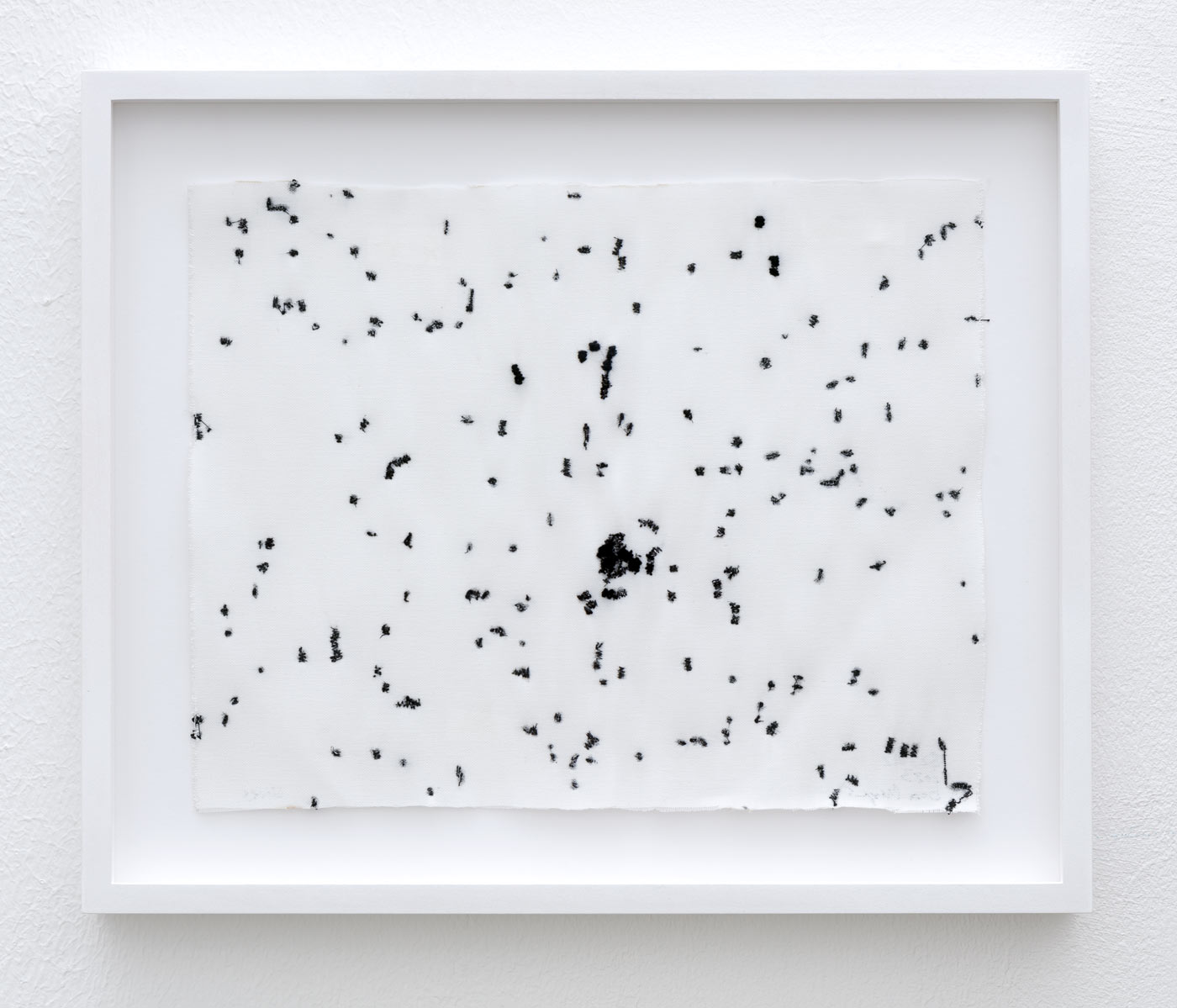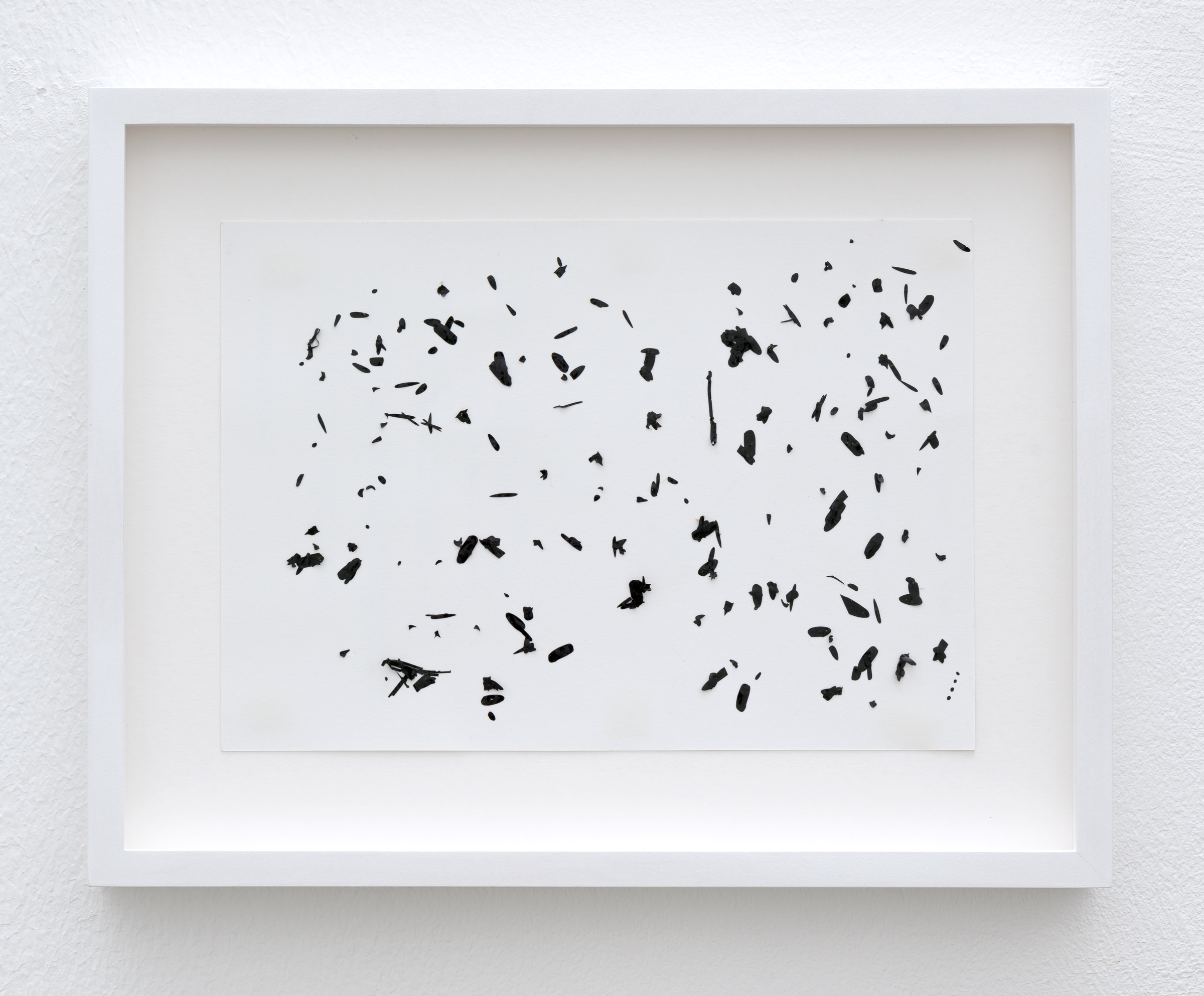
STREUUNGEN (SCATTERINGS)
According to ethnologist Matthias Kings, the Greek verb diasperein (to disperse) originally referred to an abrupt but natural process, namely „the fertile breaking away of the seeds of a plant body, which simultaneously disperses and reproduces the organism.“ The black particles that colonize Bea Meyer’s embroideries, photographs and prints are also the result of an abrupt breaking away. They are cut lint, created when black fabric is cut up. They fell unnoticed onto the white table top and finally into the artist’s field of vision. They lay there like seeds, like cloth pepper that had been ground into nothingness with a textile mill, lay there like grist, seed, litter, without purpose, without ability, they rested in a state of random distribution and aroused Meyer’s interest in an aesthetic of abrupt distribution. Using cultural means and techniques, she reproduced the scattered material or the materialized scattering – in order to understand the process and thus follow an urgent interest in the spontaneous and random, which the artist has increasingly developed in recent years.
With intuitive, playful procedures, new themes and forms of expression are finding their way into Bea Meyer’s work. However, these relate to her previous work rather than detaching themselves from it. Meyer calls her latest group of works “Scatterings”, referring to a term from statistics, whose methods of representation and exploration she has appropriated as artistic strategies and procedures in a number of older works – speculative assumptions, conducting conversations, collecting data and finally translating the results into a system of signs. In statistical jargon, what generally becomes invisible in this system of signs, is called dispersion – values that scatter around the result of the statistical calculation, around the mean value depicted. But to which mean, which calculated norm, do Meyer’s “Scatterings” refer? Where is the stability and acceptance-promising direction to which they relate? The answer is quite simply that there is no such thing. The center is a memory of a fictitious wholeness, a hallucination. Bea Meyer has fruitfully allowed it to break away and reproduced this moment again and again. Where otherwise lengthy considerations and conceptual procedures precede the concrete work on the material, Meyer has allowed the suddenness of a seemingly meaningless event to set a comprehensive artistic production in motion. Without renouncing craftsmanship, precession and conceptual rigor, Meyer impressively gives new meaning to the aesthetics of the abrupt in her work “Scatterings”.
Carsten Tabel, 2024





Johannes Makolies intensively deals with the formal and material language of urban spaces and urban architecture. Makolies‘ works refer formally and aesthetically in a variety of ways to reference systems of our artificially created environment and increasingly operate at the interface between fine art and materials research. The visualisation of material properties in connection with a sculptural form and its effect in space are the subject of his research.
In addition to clear contours and a rather minimalist, sometimes brutalist-looking design, his work is characterised by the combination of classic sculptural materials (concrete, glass, steel) with more atypical materials such as construction foam, acrylic, epoxy resin, carbon and glass fibres; found objects are also a recurring element of his work. The combination, reworking, sequencing and variation result not only in an often idiosyncratic material aesthetic, but also in a special pictorial quality and depth that is fuelled by the energy of the past but at the same time points to the future.





RAUSCHEN (WHITE NOISE)
Dancing pixels, drifting snow or abstract hieroglyphs on shrunken fibers? „Rauschen #3“ does not want to satisfy our desire to grasp images at a glance. A curtain of need for communication and refusal. A riddle: large, soft and warm. A data carrier, timeless and difficult to date, tightened by gravity. „Data is the new oil“, a new profitable raw material. The digital mass of information collected about us as individuals is stored formlessly and immaterially on servers in lapidary places around the world.
Bea Meyer adds a new form and own materiality to her data. She reduces and condenses the digitized images of her handwritten calendar notes from the last 15 years into a textile, wall-sized display and hangs it in public. The cryptic text is the “Message”. The plain text lies open in Meyer‘s book „VOR“.
CVs have become bubbling sources of data. Our everyday online life flows twentyfourseven in digital morsels into the memory chambers of other companies. Our ego is condensed somewhere as a digital image. We keep a storage space as our company, a resting place disguised as a cloud. Click by click, our ego moves across to become a quarry for artificial intelligence in real time. We are now at the mercy of active algorithms that feign loyalty to us, while they tamper with our data unobserved.
We have long since become careless and transparent, living with the paranoia of being digitally tracked and therefore transparent. Smartphones and iPads keep an automated record of what we do and what we don‘t do. We have long since become accustomed to machines knowing more about us than we know about ourselves.
Bea Meyer rebels against the appropriation and fragmentation of our egos with autonomy. She calls for freedom and independence, play and self-determination, for a right to non-traceability and oblivion. She works her archaic needs for meaningfulness and warmth into a felt made of wool and printed silk to form something larger, a coherent whole. It creates something analogue, something tangible, something made by hand and calls for informational self-efficacy: „My data belongs to me! I can do what I want with it – write it down and make it accessible to everyone. And – if I want to – I can take it away again, encrypt it or delete it completely! I can turn them into books, pictures and compositions.
Michael Grzesiak, 2020, text for the installation Rauschen #3, Gasteig, Munich, abridged version



L-SERIE
Meyer records events, information — she collects data. She chronicles, lists and enumerates, documents, makes protocols. Early scientific efforts were based on recording observations. Nowadays we record and then interpret data into conclusions. She distills self-collected data into artistic formats; movement profiles, calendar records and biometric data. Who and what am I as an individual and as part of an abstract, data-generating crowd, leaving digital footprints, globally and ceaselessly?
Meyer is not self-absorbed, she rather assesses her life through an abstract empirical grasp, fascinated and perplexed by the sheer flood of information. Data becomes a providing and constituting asset to her working process.
In the Series “L”, the artist transfers details of her body surface onto pictorial space. Square, biometric maps of the artist’s outer layer morph into a constellation of physical properties, bearing likeness to a tiled array of satellite images of landscapes. Through biometric data, a body can be identified as an individual. Meyer playfully alters size and scale by transferring the images, resembling analogue maps, as a stitched record onto paper.
Data is the prime resource of our time. Using and linking massive sets of data is becoming an invaluable source of knowledge for humanity. Data has economic value,
and has thus become a tool to assert power. It allows the exertion of influence and control over others and the environment. We willingly deliver data to external entities in exchange for simplification of our daily routines, without ever being able to comprehend the extent of power we surrender. Monopolized data unveils our living conditions to institutions far removed from ourselves. “Data” exists only in plural form; there is no singular version of the word. We are capable of visually addressing a single request for directions; a mass of simultaneous inquiries on the other hand, has no perceptible form or shape: it is neither image nor object.
Meyer is intrigued by this absence and thus ponders the formal aspects of it. The abstraction of meaning, minimized and reduced character sequences that are linked to the emotional weight of a transpired moment; that’s the playing field. Thats where the nature of language as a graphic signifier parallels Meyer’s images. The artist leaves making associations to the viewer, along with the decision whether or not to enter the tacit, silent space.
Meyers works track the position between herself and society, between process, destination, manipulation and coincidence. She is trying to artistically map the border between individuality and the universally valid within the subset structures of everyday life. We riot in the streets with and through our smart phones and coordinate revolutions through digital networks. We can, as a part of a society, win collectively, and yet personally lose at the same time. Our actions will be evaluated through their recorded tracks, just like the inertia of our habits. If we define art as a reflected restatement of the reality of our lives; we may discover a plane of thought we will not be able to escape.
Michael Grzesiak, 2016, exhibition text “Landscapes and Lists”, abridged version





